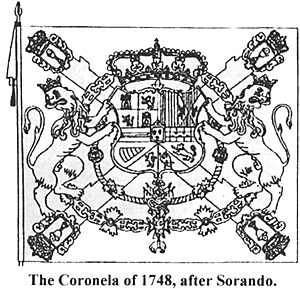Artillery
Prior to the reforms of 1763 - in imitation of those undertaken in France by Valliere, and in part supervised by him - the Royal Artillery Regiment was an amorphous body containing all field and fortress artillery (except coastal batteries) in Spain and the colonies. There was great variety in unit sizes and equipment, and an attempt had been made to reform the Artillery and Engineers in 1756 under the Count of Aranda. But resistance to such change was so great that Aranda resigned two years later, having achieved little.
The artillery uniform consisted of a blue coat with red cuffs and lining, and yellow-metal buttons (though this was little worn on service), blue trousers, white stockings, and a red long-sleeved waistcoat. As the coat was typically not worn, the waistcoat gave the appearance of a red jacket. The hat was a tricorne in black, with golden edging and the Spanish red cockade. Officers wore a better quality version of the same uniform, with gold edging to the waistcoat, and would more normally wear the coat.
Engineers
The Company of Engineers was formed from the Artillery in 1710, but did not generally have its own permanent troops until 1802, only engineering officers. Companies of Zapadores (sappers) or Minadores (miners) were formed for siege actions from infantry volunteers, who received extra pay for this duty. Officers and NCOs who volunteered also received pay bonuses and an increased chance of promotion. The Engineers uniform was as for the Artillery, but with silver buttons and hat borders. Sappers in the field also typically removed the coat, and were more likely to wear the fatigue cap than the tricorne.
 Standards
Standards
As with the organisations, the Spanish Army had received new regulations for standards in 1760, and was in the process of change. It is likely that most units actually carried their 1748 pattern colours, rather than the new styles.
The Coronela of 1748, after Sorando
The Line Infantry regiments carried four colours -- one Royal standard (the Coronela) with the first battalion, with three Colonel's colours (sencillas) -- one with the first battalion, and two with the second. The 1748 pattern Coronela was white, approximately 2.3m square, with a red Cross of Burgundy. In the centre of this was the Royal escutcheon, flanked by two crowned lions (rampant). At the four ends of the cross were the regimental arms. In 1760, the shield was changed (due to the new king), and the surrounding decoration simplified.
The Line Infantry sencillas were also white, with a red Cross of Burgundy, terminating in the regimental arms (unless there was a Provincial Militia regiment of the same name -- in which case the Line Regiment bore the Royal arms instead). The previous system of bearing the regimental name on the upper margin appears to have been dying out by this time, but still occured. Size was as the Coronela. The Swiss used the same system, but the sencillas were in the "distinctive" colour of the regiment (i.e. that used for cuffs and turnbacks), with the symbols of their various cantons at the cross terminals.
As single battalion regiments, the Militia and Light Infantry carried only a single example of Coronela and Sencilla, in a very similar style to the Line Infantry. A new Militia Coronela was ordered in 1754, but never seems to have been used.
Line Cavalry squadrons each carried a square standard in either white, blue, green or red, with the Royal arms on the obverse, and the regimental arms on the reverse. Dragoons carried guidons (with two points) in a similar style. In 1728, an ordinance had decreed that all cavalry standards should henceforth be red, but (especially due to the high quality of the early standards) this was not fully implemented until late in the century (well after the SYW).
The Spanish Guards carried a Coronela in similar style to the Line Infantry, but sown with golden fleur-de-lis. Each company carried a white sencilla, virtually identical to the Line Infantry Coronela. The Walloon Guards had the same system, but with their sencillas in blue. The Horse Guards bore two standards per company - red for the 1st, green for the 2nd and yellow for the 3rd. Each had a central emblem of a ship illuminated by the sun, and the motto "SOLVIT FORMIDINE TERRAS." The Royal Carabineers carried four standards - one white and three blue - each bearing the Royal arms on both sides.
The Artillery Regiment carried a Coronela in white, with a blue sencilla for each battalion.
Sources
I have been unable to find any good sources on the Spanish Army of the SYW in English. The following are therefore in Spanish:
Historia de la Infanteria Espaiia. Entre la Ilustracion y el Romanticismo; Ministerio de Defensa, Madrid; 1994; ISBN 84-7823-343-1
Jose Maria Bueno Carrera; Soldados de Espana. El Uniforme Militar Espanol desde los Reyes Catolicos hasta Juan Carlos I; Almena Ediciones, Madrid; 1998; ISBN 84-922644-5-4
An excellent coverage of standards is given by Luis Sorando Muzas in Antecedentes y Evolucion de las Banderas en Espana (1700 - 1978), which is on-line at the "Nec Pluribus Impar" site.
The Forces of King Charles III
- Introduction
Infantry and Household Troops
Light Infantry and Provincial Militia
Cavalry: Line, Light, and Dragoons
Artillery, Engineers, and Standards
Related
Back to Seven Years War Asso. Journal Vol. XII No. 3 Table of Contents
Back to Seven Years War Asso. Journal List of Issues
Back to Master Magazine List
© Copyright 2001 by James J. Mitchell
This article appears in MagWeb (Magazine Web) on the Internet World Wide Web.
Other articles from military history and related magazines are available at http://www.magweb.com